Decoding the Pricing of Tanzanite Rings
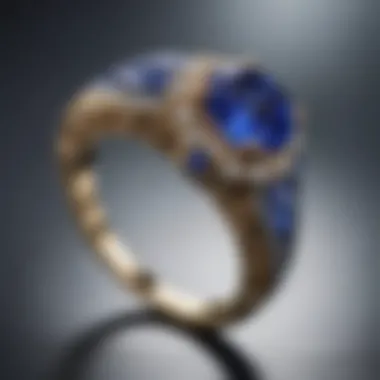
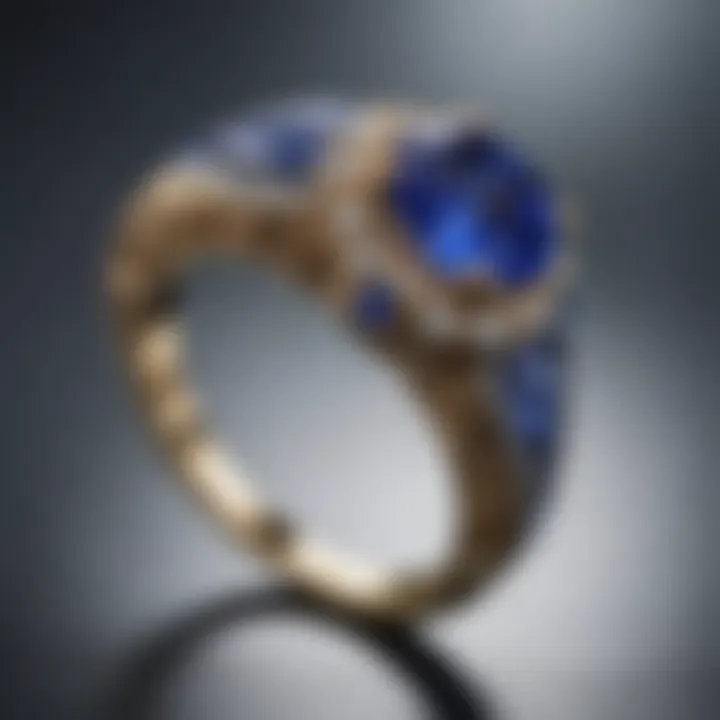
Intro
Understanding the pricing of tanzanite rings requires a deeper look into the unique qualities of tanzanite as a gemstone. This narrative will explore its characteristics, historical background, and the factors influencing its market value.
Gemstone Overview
Definition of Gemstones
Gemstones are minerals that have been cut, polished, and are typically used in jewelry. They are valued for their beauty, rarity, and durability. Tanzanite, a variety of the mineral zoisite, is considered a semi-precious gemstone. Its rich blue-violet hue sets it apart from many other stones.
Classification of Gemstones
Gemstones are generally classified into two main categories: precious and semi-precious. Precious gemstones include diamonds, rubies, sapphires, and emeralds due to their high value and demand. Semi-precious stones, such as tanzanite, are more abundant but can still carry significant value depending on their attributes. Factors such as color saturation, clarity, and cut determine a stone's classification and market demand.
Historical Significance
Origins of Gemstone Use
The use of gemstones dates back thousands of years. Early civilizations prized stones for both decorative and ceremonial purposes. The discovery of tanzanite in the 1960s marked its entry into the gemstone market. Although recent, its rapid rise in popularity is notable.
Cultural Insights: Gemstones in Ancient Civilizations
Throughout history, gemstones have held cultural significance. In ancient Egypt, for example, gemstones were thought to have protective properties. They were used in jewelry, burial tombs, and artifacts. Tanzanite, though a modern gem, now finds itself in a lineage where other stones once reigned supreme. Its deep blue tone has drawn parallels to sapphires, capturing the interest of collectors and enthusiasts alike.
"The unique beauty of tanzanite lies in its distinct color and rarity, making it a sought-after gemstone for both collectors and those looking to purchase jewelry."
The End
Tanzanite’s pricing is the result of its classification as a gemstone, its historical significance, and the dynamic nature of the market. As we move through the subsequent sections, we will delve deeper into the factors affecting its cost, including aspects such as quality, rarity, and market trends.
Intro to Tanzanite
Tanzanite is a gem that intrigues both collectors and casual viewers alike. Its unique hue and rich history add to the allure. This article will delve into the multifaceted aspects of tanzanite, particularly the cost associated with tanzanite rings. Understanding the background of this gemstone aids in grasping why prices can vary significantly.
Exploring tanzanite’s origins, geological significance, and market demand reveals crucial elements that influence its value. Tanzanite is not merely a beautiful stone; it is a precious commodity shaped by various factors. Knowing these factors is essential for anyone considering purchasing tanzanite jewelry. In this section, we will focus on the origins and discovery of tanzanite, as well as its geographical significance.
Origins and Discovery of Tanzanite
Tanzanite was first discovered in the 1960s in Tanzania, specifically near Mount Kilimanjaro. The initial find was made by a Masai tribesman, who discovered the blue-violet stones in the area. Recognized for their beauty, these stones captured the attention of gemologists. The gem was named "tanzanite" in 1968, reflecting its geographical origin.
Following its discovery, tanzanite quickly entered the gemstone market. It was showcased by Tiffany & Co., which played a significant role in its popularity across the globe. However, despite its recent introduction to the market, tanzanite possesses an exceptionally rich narrative. The legend surrounding its discovery contributes to its overall value.
Geological and Geographic Significance
The rarity of tanzanite is closely linked to its geological formation. This gemstone is a variety of the mineral zoisite that occurs only in one place on Earth: Tanzania. The formation of tanzanite results from the specific combination of heat and pressure over millions of years. The geological conditions required for its creation are unique and not replicable elsewhere.
Furthermore, the geographic specifics of Tanzania add to the allure. The region is known for its stunning landscapes, but it is also politically and economically precarious. This geopolitical aspect makes tanzanite even more scarce. The limited supply combined with the increasing global demand enhances its value significantly.
"Tanzanite's singular geographical occurrence limits its supply, creating a dynamic market for this precious stone."
In sum, understanding the history and geography of tanzanite not only enhances appreciation for the gem itself but also informs potential buyers about the factors that influence the pricing of tanzanite rings.
Understanding Tanzanite’s Value
Tanzanite's value is derived from multiple factors, each playing a crucial role in how prices are determined. Understanding these elements helps potential buyers and aficionados recognize why tanzanite can demand significant prices. These factors include quality markers like color, clarity, cut, and carat weight. They also provide insights into the gemstone's market positioning. Thus, being well-informed about tanzanite's value ensures that purchasers make educated decisions, whether for investment or personal enjoyment.
Factors Influencing Gem Value


Color
Color is perhaps the most vital factor when assessing the value of tanzanite. The most sought-after stones display a rich, deep blue with violet undertones. These colors are often the result of specific geological conditions during the gemstone's formation.
A tanzanite with a vivid and homogeneous color commands higher prices. This consistency can significantly benefit the buyer, as it creates an appealing aesthetic that enhances any jewelry design.
However, stones that exhibit too much gray or brown can lower the overall value. Consequently, consumers should prioritize tanzanite that retains that vivid tone for maximum impact.
Clarity
Clarity measures the presence of inclusions or blemishes within the stone. Higher clarity gemstones are typically more valuable because they allow light to pass through more freely, enhancing brilliance. The best tanzanites show minimal inclusions and a clean appearance. This cleanliness is an attractive trait and contributes to the gem's value.
The unique aspect of clarity in tanzanite is that it often correlates with the stone's overall visual appeal. Stones with high clarity can exhibit deeper color saturation, resulting in more visually striking jewelry. Conversely, lower clarity tanzanite can detract from its splendor and, thus, diminish its value.
Cut
The cut influences a tanzanite's overall shape and how it reflects light. An expertly cut gemstone showcases its color and brilliance. Various styles exist, ranging from classic round cuts to modern fancy shapes. Each cut may affect the final price and desirability of the gem.
A key feature regarding cut is its potential to enhance the tanzanite's innate qualities. A well-cut stone not only adds to its beauty but can also improve its perceived value in the market. On the other hand, poorly cut tanzanite may appear dull or lackluster, reducing its overall charm and desirability.
Carat Weight
Carat weight indicates the size of the tanzanite. Larger stones typically come with higher prices due to their rarity. However, it's worth noting that size alone does not dictate value. The evaluation must consider the combined effect of carat weight with color, clarity, and cut.
The distinctive aspect of carat weight is how it interacts with other value factors. A moderately sized stone with exceptional color and clarity may be more valuable than a larger, less captivating tanzanite. Therefore, potential buyers should assess every aspect holistically, instead of focusing solely on size.
Rarity and Market Demand
Rarity significantly influences the demand for tanzanite. Being found exclusively in Tanzania, this gemstone’s limited origin enhances its desirability among consumers. The growing awareness of its unique beauty has also led to increased popularity in recent years.
As market demand continues to rise, the pressure on supply can drive prices higher. This interaction between rarity and market demand is vital for any buyer to understand. Knowing that tanzanite is a finite resource amplifies the importance of purchasing choices today, ensuring that one invests wisely in this captivating stone.
Price Range of Tanzanite Rings
Understanding the price range of tanzanite rings is crucial for anyone interested in purchasing this rare gemstone. The cost of these rings can vary widely based on multiple factors, including quality, type, and marketplace. By grasping the nuances of retail prices and auction values, buyers can make informed decisions. Knowing how to navigate the market can help in identifying fair pricing, ensuring a good investment, and maintaining the integrity of the purchase. This section provides an overview of both retail and auction prices, highlighting what factors contribute to these values.
Retail Prices
When exploring retail prices for tanzanite rings, one must consider several aspects. Retail prices are what customers typically pay at jewelry stores, and they reflect several key components:
- Quality of the Gemstone: The aspects of color, clarity, cut, and carat weight affect the retail price directly. Higher quality stones will command higher prices.
- Setting and Design: The type of metal used, such as white gold, yellow gold, or platinum, as well as the intricacy of the ring's design, will also influence the overall cost. More elaborate settings may add significantly to the price.
- Retailer Markup: Retailers often apply a markup to account for their business costs and profit margins. This markup can vary widely from one jeweler to another.
For example, a simple tanzanite solitaire ring might range from $300 to $1,500, while more intricate designs such as halo settings can range from $1,500 to over $5,000. Ultimately, buyers are encouraged to compare prices across different retailers to ensure they receive a fair deal.
Auction and Wholesale Values
Auction and wholesale values present an alternative perspective on the prices of tanzanite rings. Understanding this segment can help potential buyers who are looking for better deals or investment opportunities. Here are some key points to consider:
- Market Fluctuations: The prices at auctions can be more volatile. They depend greatly on current demand and the quality of the stones being sold. Buying at auctions may yield lower prices than retail, especially if bidding conditions are favorable.
- Wholesale Opportunities: For jewelers or collectors, wholesale prices can be considerably lower than retail, reflecting bulk purchases and direct sourcing from suppliers. These values generally provide a better insight into the actual market worth of tanzanite.
- Value at Resale: It is essential to consider how auctions can affect the future resale value of a tanzanite ring. A ring purchased at auction may have appreciated in value over time or may be sold for less if market conditions shift.
"The auction market brings a unique and dynamic pricing structure, enabling buyers to potentially acquire tanzanite rings at lower prices, provided they are well-informed about market conditions."
Overall, understanding the difference between retail and auction prices, along with factors influencing these costs, equips potential buyers with the knowledge needed to navigate the tanzanite ring market effectively.
Types of Tanzanite Rings
Understanding the types of tanzanite rings is vital for anyone interested in purchasing one of these exquisite pieces. Each type offers distinct characteristics, aesthetic appeal, and potential for emotional significance. Knowing the options allows buyers to make informed decisions suited to their preferences.
Solitaire Rings
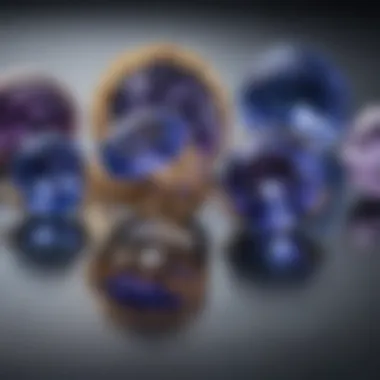
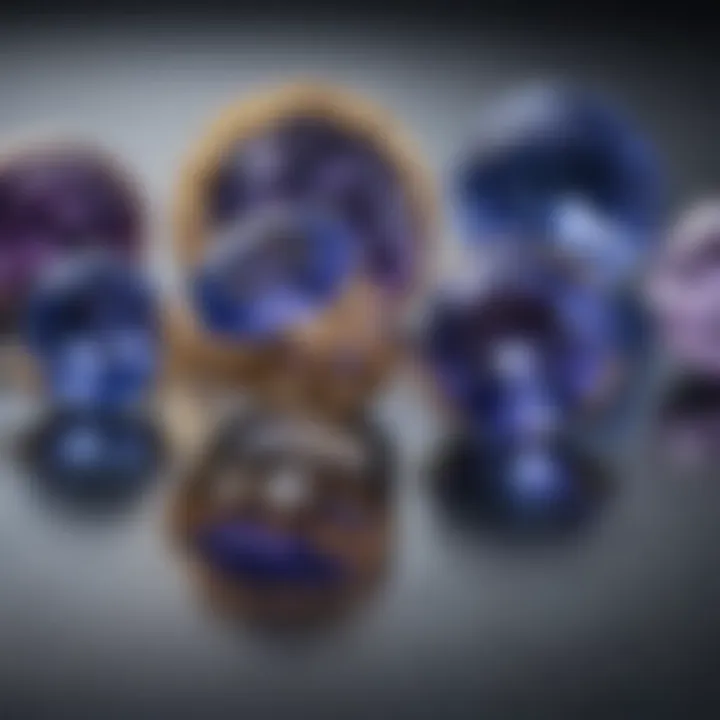
Solitaire tanzanite rings are quite popular due to their timeless elegance. A single tanzanite stone takes center stage, often in a simple yet sophisticated setting. The focus on the stone enhances its color and clarity, making it the ideal choice for those who appreciate minimalism. When selecting a solitaire ring, consider the cut of the gem. The cut affects how light interacts with the stone, contributing to its brilliance. Carat weight is also essential. Larger tanzanite stones often command higher prices, but a smaller well-cut stone can be more captivating than a larger, poorly cut alternative.
Halo Rings
The halo design consists of a central tanzanite stone surrounded by smaller diamonds or gemstones. This configuration accentuates the primary stone, enhancing its visual impact. Halo rings can be very attractive for those looking for a statement piece. These rings tend to have a higher price point due to the additional stones and intricate settings. When evaluating a halo ring, it is crucial to assess the quality of both the tanzanite and the surrounding stones. A well-crafted halo can create a stunning contrast, amplifying the deep blue of the tanzanite.
Three-Stone Rings
Three-stone tanzanite rings symbolize the past, present, and future, adding sentimental value. This design features one prominent tanzanite stone flanked by two smaller stones, which could be diamonds or other complementary gemstones. This type of ring appeals to those who appreciate meaningful jewelry with a narrative. The arrangement allows for creative expression through various combinations of colors and stone sizes.
The price of three-stone rings can vary significantly based on the choice of side stones and their quality. For buyers, it is advisable to ensure that all three stones are well-matched in terms of color and clarity to create a cohesive look.
Knowing these types of tanzanite rings aids potential buyers in making choices that resonate with their style and budget. Each design embodies uniqueness and artistry, which elevates the overall experience of buying a tanzanite ring.
Comparative Analysis with Other Gemstones
A comparative analysis with other gemstones is essential for understanding the cost and value of tanzanite rings. This analysis allows buyers to appreciate distinctive features and qualities of tanzanite in relation to other popular gemstones in the market. Additionally, it helps buyers make informed decisions when purchasing pieces, assessing their choices based on clarity, color, and rarity.
In this section, we will examine tanzanite in comparison to two notable gemstones: sapphire and topaz. These comparisons will highlight the unique characteristics of tanzanite, its pricing structure, and market demand.
Tanzanite versus Sapphire
Tanzanite and sapphire, both renowned for their vivid colors, often draw comparisons. Sapphire, a precious stone, typically comes in shades of blue but also appears in a variety of colors, known as "fancy sapphires." The key element that differentiates these stones is scarcity. Tanzanite, discovered in only one location in Tanzania, is much rarer than sapphire, which is sourced from multiple locations worldwide. This rarity elevates tanzanite's market value.
When it comes to color, tanzanite exhibits a captivating blue-violet hue that can vary in intensity. In contrast, sapphires range from light to dark blue, with certain hues being highly coveted. The clarity of both stones impacts their pricing. However, tanzanite tends to have more inclusions, which can affect its desirability.
Interestingly, consumer preference often plays a role in pricing. Sapphires have a long-standing reputation as classic engagement stones. This cultural significance may cause their prices to be more stable. For instance, high-quality sapphires can command prices upwards of $10,000 per carat or more. In comparison, select tanzanite rings might range from $400 to $1,200 per carat, depending on quality.
"Understanding how these gemstones behave in the market can guide collectors and buyers in making smarter choices."
Tanzanite versus Topaz
The comparison between tanzanite and topaz reveals further insights into their respective values in the jewelry market. Topaz is another popular gemstone, often available in various colors, including the vibrant blue often confused with tanzanite. However, topaz is generally more abundant and affordable than tanzanite.
In terms of color, while blue topaz may resemble tanzanite, the depth and complexity of tanzanite's color are usually more appealing to consumers. Topaz may appear more one-dimensional compared to tanzanite's rich variations.
Although topaz can be relatively inexpensive, certain types, like imperial topaz, can fetch high prices. Yet, for the average buyer, tanzanite remains significantly more valued due to its rarity and unique color. The cost of lower-quality blue topaz rings generally starts at about $50, whereas quality tanzanite rings start at significantly higher prices, reflecting their gemstone classification differences and market demand.
In summary, a comprehensive understanding of how tanzanite compares to other well-known gemstones is vital for enthusiasts and potential buyers. This knowledge influences purchasing decisions and potential resale values in the future. By carefully analyzing these differences, consumers can better appreciate the factors affecting tanzanite's positioning in the luxury jewelry market.
Factors to Consider When Purchasing
When acquiring a tanzanite ring, there are several essential factors to take into account. Understanding these elements can significantly impact your purchasing decision and the value of your investment. This section will explore key considerations that both first-time buyers and seasoned collectors must keep in mind.
Certification and Grading
Certification and grading are critical when evaluating tanzanite rings. Certified gemstones are accompanied by documentation from recognized gemological laboratories like the Gemological Institute of America (GIA). This certification verifies the gem's authenticity, quality, and characteristics. Such documents often include details about color, clarity, cut, and carat weight.
It's important to note that tanzanite has a range of colors from deep blue to violet. The most valuable stones exhibit a vivid blue hue with minimal inclusions. Therefore, understanding the certification helps ensure that buyers are not misled about the quality of the gemstone.
Additionally, grading scales can vary by laboratory, which can create confusion. Familiarizing yourself with the grading standards of various certifying organizations can help you make informed choices.
"Official certifications provide reassurance and enhance the gemstone's perceived value in the market."
Reputable Dealers and Sources
Choosing a reputable dealer is crucial for a successful purchase of a tanzanite ring. In the jewelry market, transparency and trustworthiness are key factors. Seek out dealers with a strong track record, positive reviews, and affiliations with recognized professional organizations. These dealers often provide guarantees and return policies, ensuring that you are not left with a poorly graded gem.
Acquiring tanzanite from reputable sources also includes being aware of the origin of the gemstone. Tanzanite is primarily mined in Tanzania, and knowing the source can add to the story and emotional value of the piece.
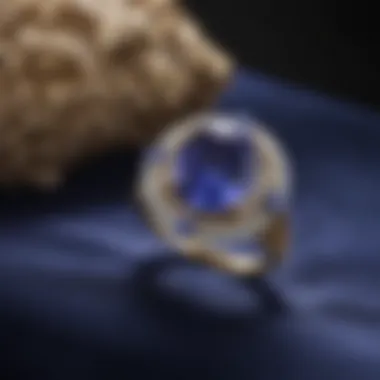
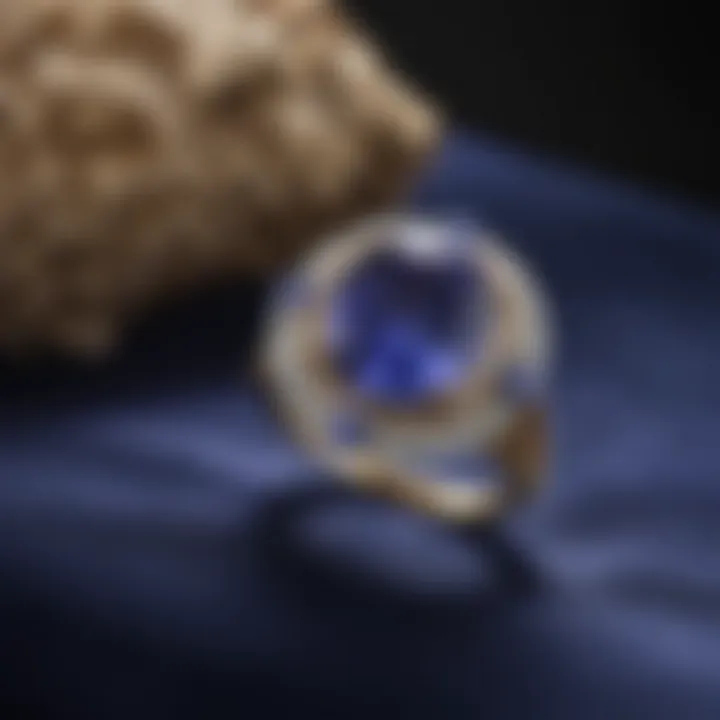
Additionally, consider visiting local jewelers or well-established online platforms. A trustworthy dealer will be open to discussing the gem’s history, characteristics, and any certifications associated with it. Make a habit of asking questions and don't shy away from seeking additional information. Knowing that you are buying from a knowledgeable and ethical dealer provides peace of mind.
Ultimately, both certification and reputable sources play a significant role in ensuring that your investment in tanzanite is sound, rewarding, and reflective of its true value.
Care and Maintenance of Tanzanite Rings
Tanzanite rings are exquisite pieces of jewelry that deserve proper care and attention. Understanding how to maintain these rings ensures their longevity and keeps them looking radiant. The importance of caring for tanzanite cannot be overstated. Since it is a relatively softer gemstone, it requires special handling compared to more durable gems like diamonds. In this section, we will dive into effective cleaning methods and appropriate storing guidelines, ensuring your tanzanite ring remains a cherished possession.
Cleaning Methods
Cleaning a tanzanite ring is essential to preserve its beauty and luster. Regular cleaning prevents the build-up of dirt and oils that can dull the stone's appearance. Here are a few recommended cleaning methods:
- Mild Soap Solution: Mix a few drops of mild dish soap with warm water. Use a soft cloth or a soft-bristled toothbrush to gently scrub the stone and the setting. Make sure to rinse it thoroughly under lukewarm water to remove soap residues.
- Ultrasonic Cleaners: While some jewelers recommend this method for various gemstones, caution is necessary. Due to tanzanite’s relative softness, opt for ultrasonic cleaning only if a jeweler suggests it.
- Avoid Harsh Chemicals: Chemicals found in jewelry cleaners or household products can damage tanzanite. Always double-check labels or consult a professional before using any cleaning agents.
"Proper maintenance enhances not only the appearance but also the value of the tanzanite ring over time."
Storing Guidelines
When it comes to storing your tanzanite ring, following some simple guidelines can prevent unnecessary damage. These include:
- Soft Cloth or Pouch: Always keep the ring in a soft cloth, pouch, or a dedicated jewelry box. This prevents scratches from other jewelry pieces.
- Avoid Direct Sunlight: Storing tanzanite rings in areas exposed to direct sunlight for extended periods can fade their color. Keep them in a cool, dry place.
- Separate Storage: If you have other types of gemstones, store the tanzanite ring separately. This reduces the risk of scratches and damage from harder stones.
By following these cleaning methods and storage guidelines, you can ensure that your tanzanite ring maintains its beauty for years to come.
The Future of Tanzanite in the Jewelry Market
The future of tanzanite in the jewelry market is pivotal for all stakeholders. Understanding this domain is essential for potential buyers, jewelry designers, and investors. Tanzanite is not merely a gemstone. It symbolizes a blend of rarity, beauty, and a sense of uniqueness that appeals to a specific consumer base. As consumer preferences evolve, so does the demand for tanzanite. Analyzing the forthcoming trends and investment possibilities is critical for making informed decisions in this market.
Trends in Consumer Demand
The shifting dynamics of consumer preferences affect which gemstones are most sought after. Increasing awareness about exotic and unique stones positions tanzanite favorably. Social media plays a significant role here. Platforms like Instagram showcase stunning jewelry designs featuring tanzanite, catching the attention of collectors and enthusiasts. Introductions to tanzanite through influencers also amplify its visibility.
Several trends are evident:
- Sustainability: Consumers increasingly value ethically sourced and sustainable products. This interest directly impacts tanzanite, as sustainable mining practices gain traction.
- Customization: Unique, custom designs are becoming more popular. Jewelers is focusing more on personalizing pieces with tanzanite, catering to clients looking for individuality.
- Education: More consumers seek to understand the gemstones they purchase. This trend enhances demand for tanzanite as educational resources and content become available, informing buyers about its unique qualities.
These trends suggest a continuously increasing interest in tanzanite, potentially stabilizing or raising its market value over time.
Potential for Investment
Investment in gemstones like tanzanite often causes hesitation among buyers. However, understanding market dynamics can help mitigate uncertainty. Tanzanite offers specific advantages as an investment choice. Its limited geographic origins and relative rarity enhance its investment appeal.
Consider the following factors regarding investment potential:
- Rarity: The mine in Tanzania from which tanzanite is extracted is running low on quality stones. This scarcity may lead to price increases in the future as supply diminishes.
- Market Growth: The growth trajectory of the luxury jewelry market suggests broader acceptance and interest in unique gems like tanzanite. Increased consumer interest typically supports rising values.
- Long-term Value: Investing in quality tanzanite can yield positive returns. Many investors have experienced price appreciation over time.
- Diversification: Including tanzanite in a gemstone collection provides diversification. This can cushion against fluctuations in the broader market.
Understanding the future market landscape of tanzanite aids buyers and investors. Stay informed about trends and purchasing patterns.
Closure
In this final section, we summarize the essential elements that have been discussed throughout the article regarding Tanzanite rings. Understanding the cost of these rings is not only about the price tag but is deeply tied to various factors including the gemstone's quality, rarity, and market demand. As consumers and enthusiasts navigate the jewelry market, it is crucial to recognize how these elements interplay to shape pricing.
Summary of Key Points
Several key points stand out in relation to Tanzanite rings. First, the color, which can range from deep blue to violet, is a primary factor in determining value. The most sought-after hues can command significantly higher prices. Second, the clarity and cut of the gemstone also influence its attractiveness and market value. Clarity refers to the presence of inclusions, while cut impacts how light interacts with the stone.
Moreover, carat weight is critical; larger stones are often more valuable but may not always proportionately increase in price due to market demand and rarity. The discussion also highlighted the vast price range between retail, auction, and wholesale values, illustrating the variability depending on the source and the seller's reputation.
Finally, understanding the future trends in consumer demand surrounding Tanzanite can provide insights into potential investment opportunities. Buyers should remain informed of evolving preferences which may affect valuation over time.
Final Thoughts on Choosing a Tanzanite Ring
When selecting a Tanzanite ring, careful consideration is essential. Buyers should prioritize obtaining certification from reputable sources like the Gemological Institute of America. This ensures the authenticity and quality of the gemstone. Additionally, seeking rings from established jewelers or certified online retailers can significantly reduce the risk of purchasing lower-quality stones.
As tanzanite's popularity grows, knowing its characteristics helps in making a sound investment. Comparing it with other gemstones enhances the understanding of its unique attributes and market position. Ultimately, the choice of a Tanzanite ring should resonate with individual taste while also considering quality, investment potential, and market fluctuations. By keeping these factors in mind, one can make an informed decision that reflects both personal style and financial awareness.



